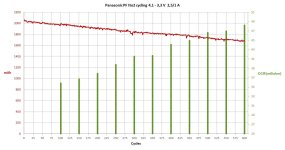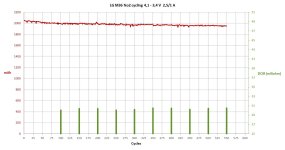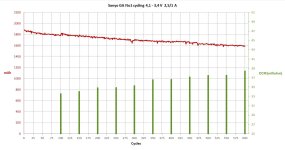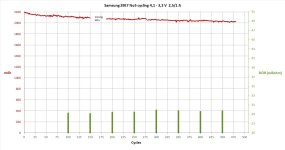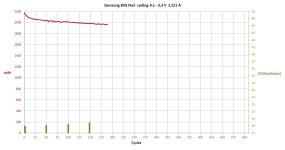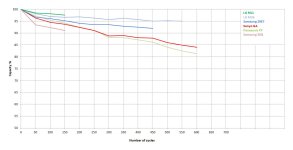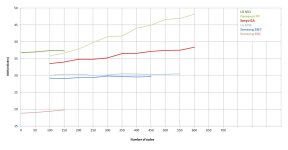You are using an out of date browser. It may not display this or other websites correctly.
You should upgrade or use an alternative browser.
You should upgrade or use an alternative browser.
Li-ion cells cycle ageing
- Thread starter docware
- Start date
Yes, M36 looks very nice, 29E is also good, especially DCIR. PF not so, on the other hand PF can serve lot of years for many people. This test confirms good 29E lifetime flippy always insisted, speak nothing of excelent LG M36 pajda each time highlighted.
It takes about 11 weeks to do 500 cycles. My intention is to finish testing at latest 700 cycles. I suppose for most of community will be 700 cycles data informative enough and testing another cells will be more interesting. Moreover, we haven´t enough time frame for long term testing.
Want to remind that this is „laboratory“ testing only, performed at specific testing conditions and stable temperature. Real battery pack conditions can differ significantly.
It takes about 11 weeks to do 500 cycles. My intention is to finish testing at latest 700 cycles. I suppose for most of community will be 700 cycles data informative enough and testing another cells will be more interesting. Moreover, we haven´t enough time frame for long term testing.
Want to remind that this is „laboratory“ testing only, performed at specific testing conditions and stable temperature. Real battery pack conditions can differ significantly.
Cephalotus
10 kW
- Joined
- Jun 18, 2012
- Messages
- 755
docware said:It takes about 11 weeks to do 500 cycles. My intention is to finish testing at latest 700 cycles. I suppose for most of community will be 700 cycles data informative enough and testing another cells will be more interesting. Moreover, we haven´t enough time frame for long term testing.
It is your test, so obviously you are free to do what you want
If you would like to get a broader audience a very long cyling test would be of high interst to solar home storage users, for which your cycling system with partial discharges at moderate C-rates does fit quite well.
Those are interested about cycling performance up to 5,000 equivalent full cyles (a solar battery system in Germany experiences around 250 equivalent full cycles per year and people hope that those will last up to 20 years)
We are talking about systems in the range of mostly 5kWh to 10kWh, so up to 1000 cells, so the interest in such testing would be of significant value.
Here is a DIY example with Panasonic PF cells:
https://www.photovoltaikforum.com/thread/114773-eigenbau-eines-liion-speichers-mit-5kwh-nutzbarer-energie/?postID=1457180#post1457180
At least in Germany the solar home storage segment is already larger (in GWh battery capacity) than the e-bike segment. (but both marktes are dominated by commercial systems, not DIY)
Pajda
10 kW
Shunt said:Once christmas is in the books , I'm going to try to get the equipment to help with this testing. Notably 2C and 3C loads on M36 , 30Q, 29E, M29, VTC6, and Sanyo UR18650NSX up to around 300 cycles.
This is highly appreciated.
Wow that is an **incredibly** useful couple of charting formats!
I would like to propose, as a standard for how many cycles to cover:
______
The 1A rate is fine, but to be more fair, what about using 0.5C for comparability across a wide range of cell capacity sizes?
so larger cells aren't artificially rewarded and smaller capacity models aren't penalized
I would like to propose, as a standard for how many cycles to cover:
however many is required to show 10% loss of capacity from new
more is always welcome but optional
500 cycles as the minimum
______
The 1A rate is fine, but to be more fair, what about using 0.5C for comparability across a wide range of cell capacity sizes?
so larger cells aren't artificially rewarded and smaller capacity models aren't penalized
john61ct said:The 1A rate is fine, but to be more fair, what about using 0.5C for comparability across a wide range of cell capacity sizes?
so larger cells aren't artificially rewarded and smaller capacity models aren't penalized
I´ve been trying to choose such testing parameters that are close to real ebike conditions (charge, discharge, DOD), I mean ebike, not scooter or motorcycle. 500 cycles minimum, 700 cycles will be probably max.
Our task is not to be fair to the cells, our task is an effort to simulate real conditions. That´s why I use the same parameters for all cells, that´s why I don´t think in 1C, 0,5C, 0,3C category.
flippy
1 MW
- Joined
- Aug 12, 2015
- Messages
- 2,351
docware said:john61ct said:The 1A rate is fine, but to be more fair, what about using 0.5C for comparability across a wide range of cell capacity sizes?
so larger cells aren't artificially rewarded and smaller capacity models aren't penalized
I´ve been trying to choose such testing parameters that are close to real ebike conditions (charge, discharge, DOD), I mean ebike, not scooter or motorcycle. 500 cycles minimum, 700 cycles will be probably max.
Our task is not to be fair to the cells, our task is an effort to simulate real conditions. That´s why I use the same parameters for all cells, that´s why I don´t think in 1C, 0,5C, 0,3C category.
i run my tests in 4 runs:
baseline (aka: verification of datasheet lifecycle),
max ratings (of datasheet),
actual expected use,
highest possible abuse the cell can see in that application.
that usually gives me a solid baseline for expected performance over time of the lifespan of the pack i am building.
Docware,
When you decide to finish cycle testing, could you please make a full cycle test as per datasheet (for me at least on the PF )? Would be good to see if full capacity will have the same degradation than the voltage limited one...
Thank you for all your efforts doing these tests!
T.
When you decide to finish cycle testing, could you please make a full cycle test as per datasheet (for me at least on the PF )? Would be good to see if full capacity will have the same degradation than the voltage limited one...
Thank you for all your efforts doing these tests!
T.
Sure, the more info the better when drilling down to the use-case-specific details on a particular battery.flippy said:i run my tests in 4 runs:
baseline (aka: verification of datasheet lifecycle),
max ratings (of datasheet),
actual expected use,
highest possible abuse the cell can see in that application.
that usually gives me a solid baseline for expected performance over time of the lifespan of the pack i am building.
But being able to quickly "scan compare" dozens of batteries for one simple factor requires a simplified apples-to-apples benchmark
takyka said:Docware,
When you decide to finish cycle testing, could you please make a full cycle test as per datasheet (for me at least on the PF )? Would be good to see if full capacity will have the same degradation than the voltage limited one...
Thank you for all your efforts doing these tests!
T.
Yes, that is my intention. Only difference is that full cycle will not be at 0,2C but at 1 A for all cells, because i measured all cells full cycle capacity at 1 A before start of the test.
Here is example of GA comparison at the beginning (3 330 mAh) and after 611 cycles (3087 mAh) That is 92,7 % of initial capacity, which is better than 84,1 % at the cycling interval 4,1 – 3,4 V.
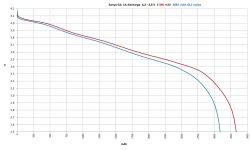
I could be mistaken, but I don't think many vendors in the states had the M36 , until very recently, but I just noticed that IMR has them for $3.49USD/ea . I can't wait to see how they do at 2C . Is there any chance one of you guys could run 100 cycles at 5 or 6 amps before I get my equipment ? Just so I know if it's even worthwhile to start them at that rate?
Shunt said:M36 - I can't wait to see how they do at 2C . Is there any chance one of you guys could run 100 cycles at 5 or 6 amps before I get my equipment ? Just so I know if it's even worthwhile to start them at that rate?
No, there isn´t. By the way, MJ1 is probably better choice than M36 for such load.
Honk
100 W
- Joined
- Oct 10, 2011
- Messages
- 230
docware said:Christmas package special delivery.
PF and GA 600 cycles, M36 550 cycles, 29E7 480 cycles, 30Q 189 cycles, MJ1 150 cycles. Comparative charts on capacity and DCIR added.
Hi
Great charts and testing but something strikes me as odd.
When charged to 4.1V the cells should be approx 90% full, meaning e'g 29E should have about 2.6ah capacity available.
But the chart starts 2.2ah ???
Could you please explain this in case I have missed some test info!
Love this type of number crunching tests that reveal crucial data. Keep up the good work.
Pajda
10 kW
Honk said:Hi
Great charts and testing but something strikes me as odd.
When charged to 4.1V the cells should be approx 90% full, meaning e'g 29E should have about 2.6ah capacity available.
But the chart starts 2.2ah ???
Could you please explain this in case I have missed some test info!
Love this type of number crunching tests that reveal crucial data. Keep up the good work.
In short: docware`s data are correct.
29E cell have declared typical capacity of 2.85Ah and minimum capacity of 2.75Ah, so you can count with ca 2.8Ah for a new cell. Typical capacity is measured at 100% DoD (4.2-2.5V), with 0.2C discharge rate and 50mA charging cut-off current. You are right that charged at 4.1V you will get ca 90% of typicial capacity = ca 2.5Ah at 0.2C discharge rate down to 2.5V! But docware is using narrower SoC window 4.1-3.3V which cost another significant amount of energy, particularly if you discharge at higher C rates. docware is using ca 0.9C discharge rate, not 0.2C used for typical capacity.
docware said:
Nice charts I love them! Thanks alot for it!
MJ1 so cool new cell that give you epic and long performance life.
I'm stuck with my used PFs but it could be worse if I had used my used and old Sony V3 10A capable in my latest battery build, cells who have degraded down to only 1800-2100mah which when new had 2150mah.
EDIT: just found this on random photo search by accident!
https://chargedevs.com/newswire/tesla-battery-boffins-describe-million-mile-cell-in-new-paper/
Honk
100 W
- Joined
- Oct 10, 2011
- Messages
- 230
Pajda said:In short: docware`s data are correct.
Hi Pajda and thank's for the clarification.
I suspected this was the case but it's better to ask than being uncertain.
So far LG M36 looks like the new killer cell stealing the crown in terms of cycle ageing properties.
I believe Pajda´s explanation is sufficient. Bellow is 29E7 No5 full capacity measured before cycling test. Initial 2 200 mAh at the start of cycling is 78,8 % of full capacity.
As the latest long life cell from Jeff Dahn´s team will not be available to us early, M36 seems to be really good choice for some time. 8)
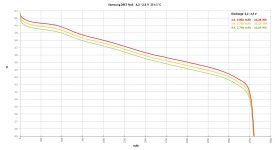
As the latest long life cell from Jeff Dahn´s team will not be available to us early, M36 seems to be really good choice for some time. 8)

Cephalotus said:docware said:It takes about 11 weeks to do 500 cycles. My intention is to finish testing at latest 700 cycles. I suppose for most of community will be 700 cycles data informative enough and testing another cells will be more interesting. Moreover, we haven´t enough time frame for long term testing.
It is your test, so obviously you are free to do what you want
If you would like to get a broader audience a very long cyling test would be of high interst to solar home storage users, for which your cycling system with partial discharges at moderate C-rates does fit quite well.
Those are interested about cycling performance up to 5,000 equivalent full cyles (a solar battery system in Germany experiences around 250 equivalent full cycles per year and people hope that those will last up to 20 years)
We are talking about systems in the range of mostly 5kWh to 10kWh, so up to 1000 cells, so the interest in such testing would be of significant value.
Here is a DIY example with Panasonic PF cells:
https://www.photovoltaikforum.com/thread/114773-eigenbau-eines-liion-speichers-mit-5kwh-nutzbarer-energie/?postID=1457180#post1457180
At least in Germany the solar home storage segment is already larger (in GWh battery capacity) than the e-bike segment. (but both marktes are dominated by commercial systems, not DIY)
Hi all,
@docware
Thank you a lot for your tests and please keep going.
I build a Powerwall from LG M36 (14S60P - x2 is comming) and you cycle data is exactly what i was looking for.
Max. charge / discharge is 500mA, later round about 400mA. Im afraid how the cells and cyclelife performs.
Like Cephalotus said
The datasheet says that the cells have 80% cap after 1000 cycles - your test locks better until now.
BR
Richie
eMark
100 kW
The Samsung 29E seems to be Pajda's favorite; while the Samsung 30Q is almost derided by Pajda for its shorter cycle life (and calendar aging) when used for power tools despite its good-looking DCIR so far. Is one reason the 30Q is frowned upon as coming up short for cycle life longevity based on its use in power tools (and vaping) more than mild-mannered ebiking where the current draw requirement may only be 5 amps?
Panasonic's 21700 (Tesla Gigafactory NCA chemistry) production is still lagging behind demand. It's rumored that Tesla is also using Samsung 21700 (high capacity cells) to keep up with production demands. Apparently Tesla likes the Li-NiMnCoO2 chemistry so much for all around performance that Tesla may eventually break ties with Panasonic's LCA 21700 cells. It's nothing new that LNM 8-1-1 chemistry is giving NCA lithium chemistry a run for the money. Is it possible that the Samsung 30Q (LNM) actually has decent-to-good cycle life longevity when it's ebiking application isn't for raw performance like that of power tools and vaping?
The current thinking by Padja seems to be that 2900mAh class lithium cells have an ebiking advantage. And yet the Samsung 30Q is only 100mAh higher with its 3000mAh capacity, its 15A rating and its lower DCIR than any other cell being tested by docware (so far). The days of 29E being a darling may be a thing of the past as time marches on with on-going lithium chemisty research, innovation and improved quality control.
Panasonic's 21700 (Tesla Gigafactory NCA chemistry) production is still lagging behind demand. It's rumored that Tesla is also using Samsung 21700 (high capacity cells) to keep up with production demands. Apparently Tesla likes the Li-NiMnCoO2 chemistry so much for all around performance that Tesla may eventually break ties with Panasonic's LCA 21700 cells. It's nothing new that LNM 8-1-1 chemistry is giving NCA lithium chemistry a run for the money. Is it possible that the Samsung 30Q (LNM) actually has decent-to-good cycle life longevity when it's ebiking application isn't for raw performance like that of power tools and vaping?
The current thinking by Padja seems to be that 2900mAh class lithium cells have an ebiking advantage. And yet the Samsung 30Q is only 100mAh higher with its 3000mAh capacity, its 15A rating and its lower DCIR than any other cell being tested by docware (so far). The days of 29E being a darling may be a thing of the past as time marches on with on-going lithium chemisty research, innovation and improved quality control.
New data for new year 2020.
All cells were resting at 3,5 V / 15 °C for 2 weeks during Christmas because the table was occupied by Christmas tree. Thanks to this pause we can see some partly capacity recovery of 29E7 and GA. Capacity degradation would be probably slower in real life for these two cells.
PF and GA 700 cycles, M36 633 cycles, 29E7 560 cycles, Samsung 30Q 270 cycles, LG MJ1 235 cycles.
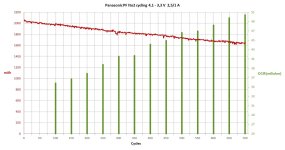
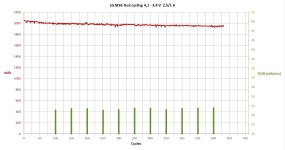
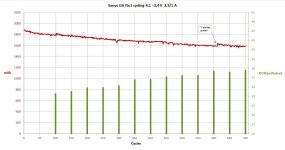

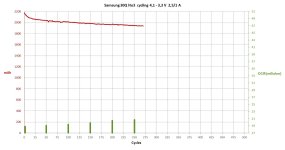
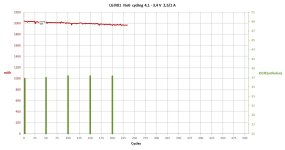


Panasonic PF and Sanyo GA reached 700 cycles and their testing has been finished (apologize to Cephalotus, richie241 and other solar home storage users ).
).
Panasonic PF after 700 cycles has 79,4 % of initial capacity in cycling interval 4,1 – 3,3 V at 2,5 A. Measuring in standard interval 4,2 – 2,5 V at 1 A shows 88,6 % of initial capacity and 87,6 % of initial energy.
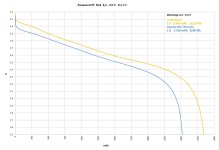
Sanyo GA after 700 cycles has 83,8 % of initial capacity in cycling interval 4,1 – 3,4 V at 2,5 A.
Measuring in standard interval 4,2 – 2,5 V at 1 A shows 91,4 % of initial capacity and 91,4 % of initial energy.
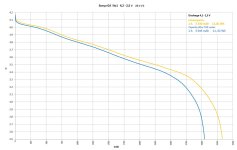
Following picture displays cell surface temperature during cycling.
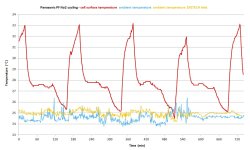

All cells were resting at 3,5 V / 15 °C for 2 weeks during Christmas because the table was occupied by Christmas tree. Thanks to this pause we can see some partly capacity recovery of 29E7 and GA. Capacity degradation would be probably slower in real life for these two cells.
PF and GA 700 cycles, M36 633 cycles, 29E7 560 cycles, Samsung 30Q 270 cycles, LG MJ1 235 cycles.








Panasonic PF and Sanyo GA reached 700 cycles and their testing has been finished (apologize to Cephalotus, richie241 and other solar home storage users
Panasonic PF after 700 cycles has 79,4 % of initial capacity in cycling interval 4,1 – 3,3 V at 2,5 A. Measuring in standard interval 4,2 – 2,5 V at 1 A shows 88,6 % of initial capacity and 87,6 % of initial energy.

Sanyo GA after 700 cycles has 83,8 % of initial capacity in cycling interval 4,1 – 3,4 V at 2,5 A.
Measuring in standard interval 4,2 – 2,5 V at 1 A shows 91,4 % of initial capacity and 91,4 % of initial energy.

Following picture displays cell surface temperature during cycling.


Similar threads
- Replies
- 47
- Views
- 12,070
- Replies
- 127
- Views
- 27,292
- Replies
- 0
- Views
- 1,500
- Replies
- 2
- Views
- 674


